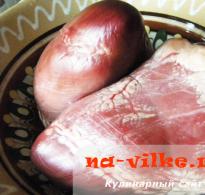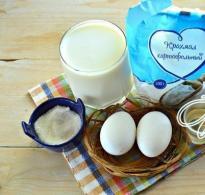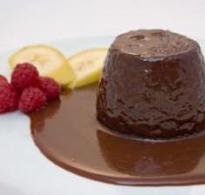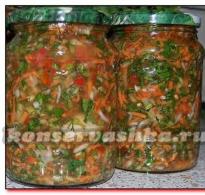Types of chanterelles. Types of chanterelle: real, trumpet, common and black
The funnel fungus is the best Finnish mushroom! September 3, 2011
In some forests of Finland, whose climate is almost no different from Karelia and many regions of the Russian North, amazing mushrooms - mustatorvisieni, considered a delicacy throughout Europe,
but for some reason little known in Russia. The scientific name for these mushrooms, which look like black, gray or brown flowers or curled dry leaves, is Craterellus cornucopioides.
Why is it so and why is it so little popular in Russia?
The name “gray fox” is considered incorrect, although it is used everywhere on the Internet. Moreover, in Russia Craterellus cornucopioides is classified as a fourth category mushroom and is not very popular, noting its low taste. But in Finland - and other foreign Europe, judging by Wikipedia - on the contrary, it is considered a delicacy.
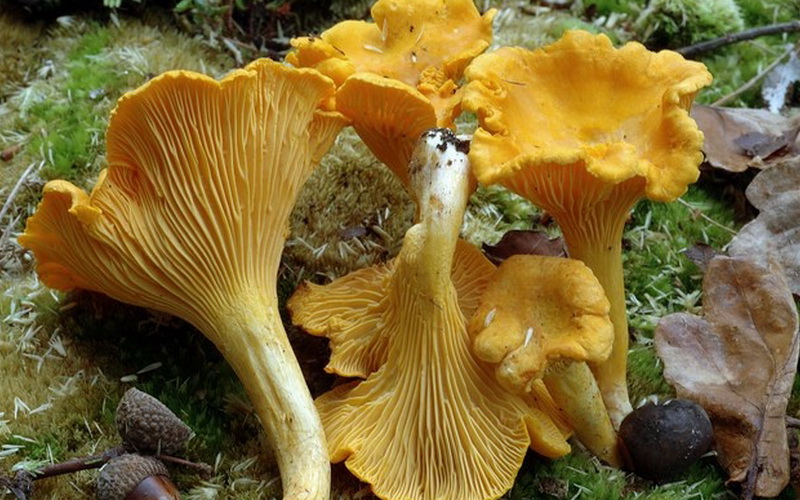
I myself met mustatorvisieni in Finland a few years after moving. I remember that we sailed to the island on a motor boat precisely in order to find and collect these mushrooms, which do not grow everywhere, but you need to know the places. So a neighbor showed us this on one of the surrounding islands. He brought us to the most ordinary clearing - collect. And he immediately bends down and puts something in the bucket. And I stand and see nothing around. Then the husband came up and said: “You’re standing on mushrooms, here they are, look carefully!”
Only when I knelt down did I see these mystical funnels and - let's collect. And you get up and again you don’t see anything.
Indeed, the funnel funnel is very difficult to distinguish in dry grass.
Actually, this is some kind of alien and mystical mushroom. Recently we went to pick him up on a motorboat to the islands with a friend: we searched and searched in the same place, completely despaired of finding it, only a few things - we didn’t see that’s all, out of grief we decided to go home - and then on the way back we saw entire colonies: as if The funnel-worm took pity on us and decided to show himself. And again we collected four buckets!
Of course, I can only make my own guesses about the reasons for the popularity of the funnelfish in Europe. They are connected with the difference between the modern European attitude towards mushrooms and the Russian one: in recent years, Europeans have increasingly been collecting mushrooms in which worms do not live at all and which do not need to be peeled, skinned from the stem, like boletus, or the cap, like russula, a - just wash it. This is why, for example, Finns prefer chanterelles and funnel mushrooms to other mushrooms.
However, funnel mushroom has one more advantage: dishes with it have a very distinct mushroom flavor, much more noticeable than other mushrooms, and lasts especially long when dried.
In Russia, especially in St. Petersburg, porcini mushrooms, similar to white boletus and boletus, are probably more associated with the mushroom as such, as well as russula, which is traditionally used for frying. Not all families even collect honey mushrooms, let alone the funnel mushroom. The unpopularity of the funnel mushroom is also due to the fact that cheese soups, where it is especially good, are not prepared as often in Russia as in Europe. Well, seasonings and sauces in which it is used are not often found on the table of Russian cuisine.
Therefore, I will tell you how mustatorvisieni is prepared in my husband’s family. 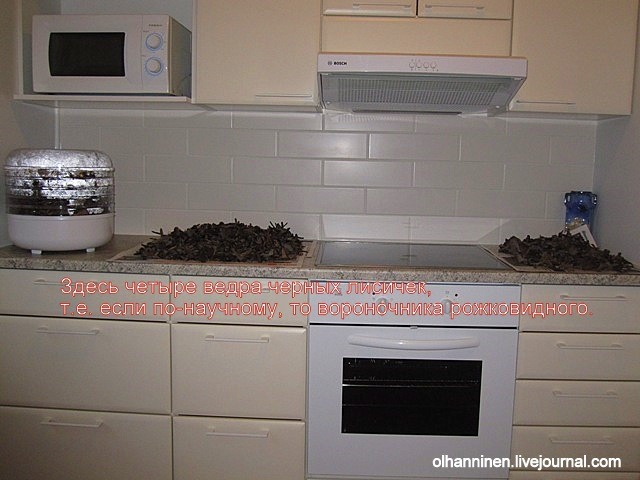
Dry in the dryer funnel-shaped funnel
for the winter. 4 more buckets are waiting their turn for drying.
Before drying, each mushroom, similar to a petunia flower, only dark in color, should be divided into two parts: it tears easily, so we use our hands, no knife is needed. This needs to be done in order, firstly, to remove snails, which really like to get into it and other dirt, and, secondly, this way it dries faster.
After drying, the mushrooms, which take up very little space when dried, are best placed in paper boxes, and some are ground in a coffee grinder to obtain a powder. , showed it here. This gives them an amazing taste! With a much stronger mushroom flavor than even dried whites.
And for soup you can use both powder and whole dried halves of mustatorvisieni, only in this case they must first be soaked for two hours in cold water and then cut into pieces. More delicious mushroom soup I’ve never eaten it, just some kind of Finnish mushroom fondue, not soup! I'll tell you about it in the next culinary post.
Also, the funnel-shaped funnel is added to, traditional dish in Finland.
Original taken from capelman c Why are chanterelles never wormy?
Gray fox in mushroom encyclopedias it can also be referred to as funnel-shaped funnel-shaped or funnel-shaped craterellus. It grows in rather large groups and bunches from August to October in deciduous-coniferous forests.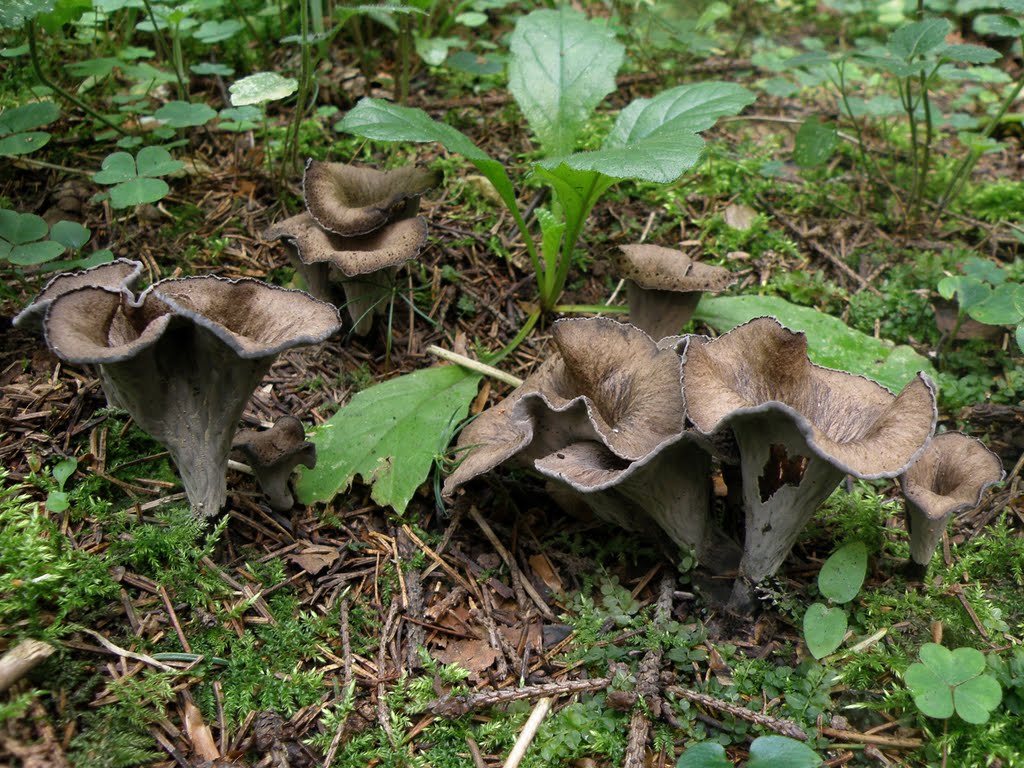 For an inexperienced mushroom picker, a mushroom evokes only one feeling: kick this mushroom, and go look further for only normal mushrooms. The appearance, of course, is still the same: unsightly, similar to the output part of a musical trumpet, black in color, growing in clusters the way toadstools usually like to grow. An experienced mushroom picker knows that it surpasses even the real yellow chanterelle in taste and aroma. And to compete with the yellow chanterelle - a mushroom classified in the first category - you still have to try.
For an inexperienced mushroom picker, a mushroom evokes only one feeling: kick this mushroom, and go look further for only normal mushrooms. The appearance, of course, is still the same: unsightly, similar to the output part of a musical trumpet, black in color, growing in clusters the way toadstools usually like to grow. An experienced mushroom picker knows that it surpasses even the real yellow chanterelle in taste and aroma. And to compete with the yellow chanterelle - a mushroom classified in the first category - you still have to try.
The funnel-shaped cap of brown-black or gray-black color has a diameter of 3 to 8 cm. In adult mushrooms, the cap is covered with a characteristic whitish coating (spores) and appears powdery. The leg is hollow inside, narrowed downward, up to 12 centimeters in length. The flesh of the mushroom is gray-black or black in color, very fragile. The color of the pulp does not change even when gray chanterelles are dried. The mushroom pulp has pleasant smell.
As you know, in Europe the black chanterelle is very popular and quite expensive. Sometimes it is even called a “truffle on a leg.” This is due not only to its high taste, but also to the ever-growing movement towards eating clean, unprocessed food. natural products. Indeed, like its yellow relative, the black chanterelle is not worm-eaten, you don’t need to peel it or carry out any other actions, just wash it and go ahead. Meanwhile, the taste of the black chanterelle cannot be forgotten. It is very strong (as is the aroma), is not lost during cooking or drying, like the yellow chanterelle, and the dried mushroom lasts longer than all other types.
Taking into account the fact that in dried form (and especially in powder) the taste of black chanterelle is enhanced, it is only prepared dried. In Europe, dried black chanterelles or their powder are most often used to make soups, cheese soups, sauces, seasonings, baked goods, preparation of minced meat and cutlets, including fish, as well as for pizza. Once soaked, the mushrooms almost completely return to their original appearance and are indistinguishable from fresh ones.
When adding black chanterelle powder to meat and fish cutlets, various sauces and seasonings, dishes acquire an amazing taste with a much stronger mushroom aroma than if dried porcini mushrooms were used for the same purposes.
For soups, you can use both powder and whole dried black chanterelle halves, but in this case they must first be soaked for two hours in cold water.
In Finland, for example, black chanterelle is added to fish cutlets with cheese, stewed in cream. And in England they make toast with butter and black chanterelle powder.
Which are widely known to all novice mushroom pickers. They gained their popularity thanks to their content useful substances, taste qualities and the absence of wormholes. It is important to learn about their varieties before heading into the forest.
Of all the types of chanterelles, the most common are:
Real,
tubular,
ordinary.
Black and white chanterelles are considered rare
The fox is real
The mushroom is valued as one of the edible species cap mushrooms. Grows in light coniferous and deciduous forests from mid-summer to September. Characteristic feature This species has a bright yellow fruit body. The outside of the hat has wavy-curled edges and a small depression in the center. Records on back side gradually descend to the stem, which is usually from 3 to 6 cm in height, sometimes reaching 10 cm, its shape is cylindrical, tapering towards the bottom. The pulp is not damaged by the larvae of forest flies and mosquitoes.The real one is eaten in dried, boiled, stewed, pickled, and salted forms.
Trumpet chanterelle
The trumpet chanterelle is named for its unique cap shape, which is tubular in shape with a funnel-shaped top and rounded edges. The color of the fruiting body varies from brown to gray, with a reddish tint less common. It grows in coniferous forests in large clusters in the same places for several years. The fruiting period lasts from early September to November. This type prefers to grow in acidic soils. The diameter of the cap is from 2 to 6 cm, the cylindrical leg is compressed from the sides and reaches 8 cm in height. Its diameter is approximately 0.8 cm.Tubular chanterelle is suitable for consumption in any form: dried, salted, fried, pickled, boiled.
The freezing and drying process preserves nutrients.
Common chanterelle
Chanterelle is the healthiest food product
Black foxes
Black ones are delicious mushrooms that can reach 10 cm in height. The fruit body is dark gray. The cap with a deep funnel is divided into two or three lobes, which do not completely merge with the stem. In deciduous forests it can be found in early autumn. You should be careful when preparing black chanterelles, as they are considered conditionally edible. Mushrooms boiled for 15-20 minutes and washed with cool water are considered optimal for eating.Nature has rewarded people with such an excellent healer. These mushrooms are a storehouse of vitamins and essential microelements. The yellow color of the mushrooms indicates a high content of carotene, which is useful for people with poor vision. The active substance ergosterol affects liver enzymes. Frequent use increases immunity.

The fox is real is a widespread edible mushroom, characterized by high productivity. It grows in numerous groups, forming so-called witch circles or wide stripes, from mid-July to mid-October, with peak fruiting occurring in July-August. You need to look for it in damp, open areas of coniferous or deciduous forest.
The initially flat-convex mushroom cap with wavy edges gradually becomes funnel-shaped, its edges become thinner and uneven. Its diameter is about 10–12 cm. The surface of the cap is forest mushroom Chanterelles are smooth, matte, whitish or bright yellow in color. The spore-bearing layer is represented by numerous thin yellow convolutions, smoothly descending onto the stalk.
The plates are folded, descending far onto the stalk, branched, thick, sparse. The stem smoothly expands upward, without a discernible border, turning into a cap, dense, yellow, smooth, up to 7 cm in length and 3 cm in thickness, cylindrical, solid.
The pulp is thick, fleshy, brittle, with a pleasant mushroom smell, and is almost never wormy.
The real chanterelle mushroom belongs to the third category of mushrooms and has a high nutritional value thanks to the vitamins and microelements contained in its tissues. It can rightfully be called universal mushroom, which lends itself to all types culinary processing, demonstrating good taste.
Goes into preparations for canning. Used without pre-treatment boiled and fried. It is prepared for future use in the form of boiled canned food (in jars), and can also be used for pickling and salting (hot method).
The main characteristics of the real chanterelle mushroom are: high content carotene, much more than in all other well-known mushrooms. In addition to carotene, this mushroom contains many other vitamins and has antibacterial properties. In some countries, chanterelle is used to prevent cancer.
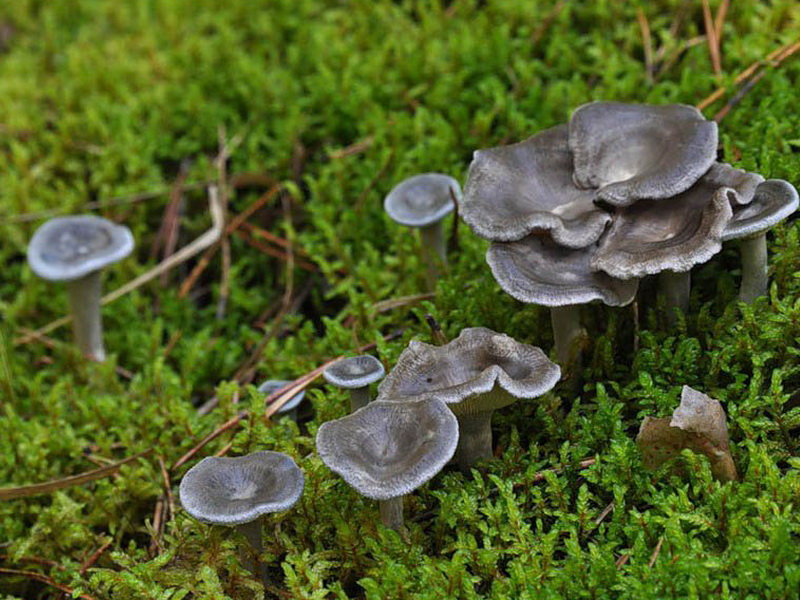
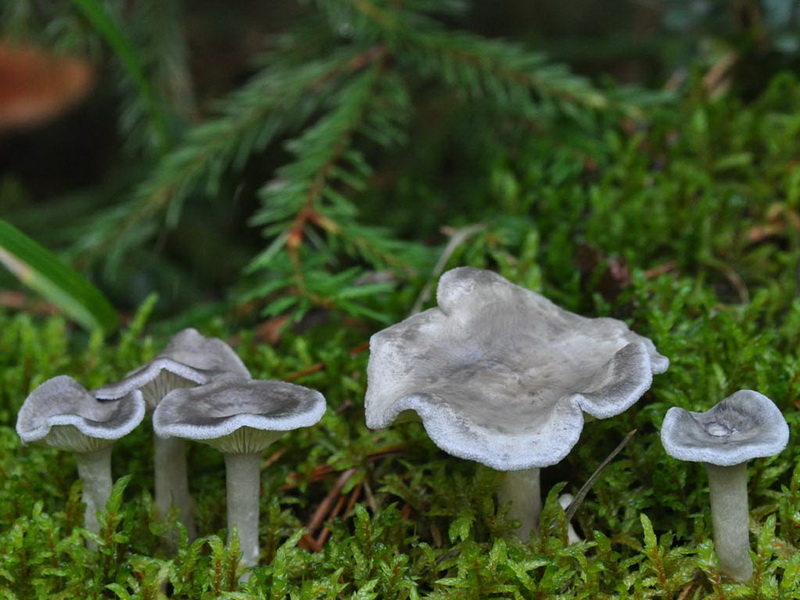
Humpbacked fox, or cantarellula, is a rather rare edible plant in Russia agaric, giving consistently high yields every year. It grows in small groups from mid-August to September, but produces especially abundant harvests at the very beginning of autumn. In what forests do chanterelle mushrooms of this type grow? You need to look for them in areas of coniferous forest overgrown with a thick layer of moss, preferably in a pine forest.
The mushroom cap is convex at first, but gradually takes the shape of a wide funnel with a diameter of about 4 cm, with a small bulge in the middle. Its surface is painted in a shiny gray color with a smoky tint and brown concentric circles. The spore-bearing layer consists of frequent grayish plates descending to the stalk. During the growth process, the plates and adjacent upper part the legs are covered with small red dots. The leg is rounded, smooth, straight, the same color as the plates. Its height is about 8 cm, and its diameter rarely exceeds 0.5 cm. The surface of the leg is smooth, with light white pubescence at the base.
The pulp is thin, soft, tender, with pleasant taste and a subtle mushroom aroma, colored grayish, which quickly turns red when the pulp comes into contact with air.
The humpback chanterelle belongs to the fourth category of mushrooms. It is eaten boiled or fried.
These photos show what real and humpback chanterelle mushrooms look like:

Chanterelle yellowing and gray: the color of forest mushrooms and their description


Chanterelle yellowing is an edible mushroom that grows in small groups from early August to late September in coniferous, predominantly spruce forests.
The shape of a chanterelle's hat resembles a deep funnel with a diameter of about 5 cm, with a curled curly edge. Its surface is smooth, matte, dry. The color of this chanterelle mushroom is yellowish-brown. The lower part of the cap is also smooth, but in mature mushrooms it becomes covered a large number thin sinuous folds descending onto the stem. She is painted in yellow with an orange tint. The stalk is rounded, thinner at the base, often curved, less often straight, hollow inside, the same color as the spore-bearing layer. Its height is about 10 cm, and its diameter is about 1 cm. The pulp is elastic, dense, brittle, light yellow, tasteless and odorless.
Yellow chanterelle belongs to the fourth category of mushrooms. It can be eaten both fried and boiled, and can also be dried for the winter.
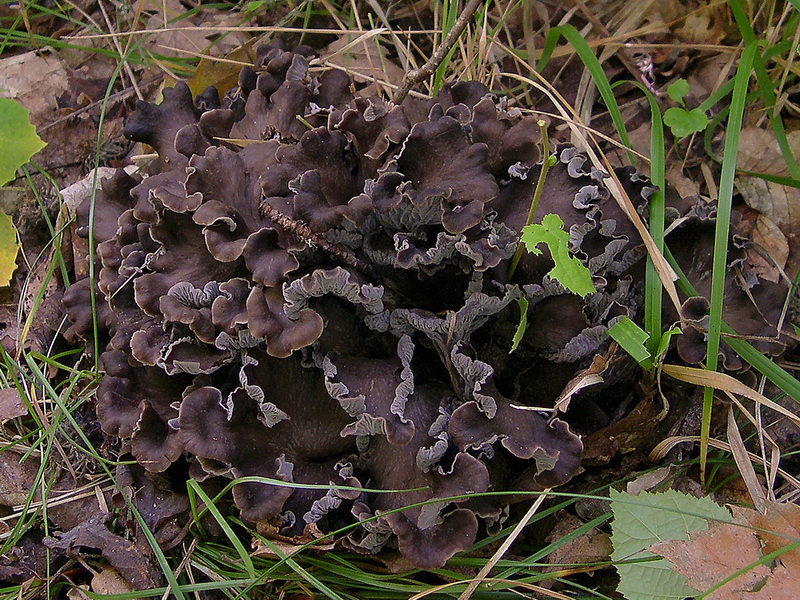

Gray chanterelle has a cap with a diameter of 3-5 cm. The cap is funnel-shaped, lobed, gray-brown-black, fading with age, the edge is drooping. The pulp is thin, with a fresh taste, without much odor. The plates are descending, gray, uneven in length, frequent, thin. The stalk is cylindrical, hollow, colored a tone lighter than the cap, size 4.0 0.5-0.2 cm. Spores are ellipsoidal, size 8-10 5-6 microns, colorless.
Nemoral forest species. The range covers Europe.
Found in deciduous forests. Fruiting bodies are periodically formed in September - October. There are single specimens.
It is protected as part of the natural complexes of the Berezinsky Biosphere Reserve, the Narochansky and Belovezhskaya Pushcha national parks. It is necessary to create specialized mycological reserves in places not covered by protective measures. It is necessary to periodically monitor the state of known populations, search for new ones and, if necessary, organize their protection by prohibiting or limiting anthropogenic impacts.
Below is a photo and description of the common chanterelle mushroom.
Common chanterelle: in which forests it grows and what it looks like (with photo)
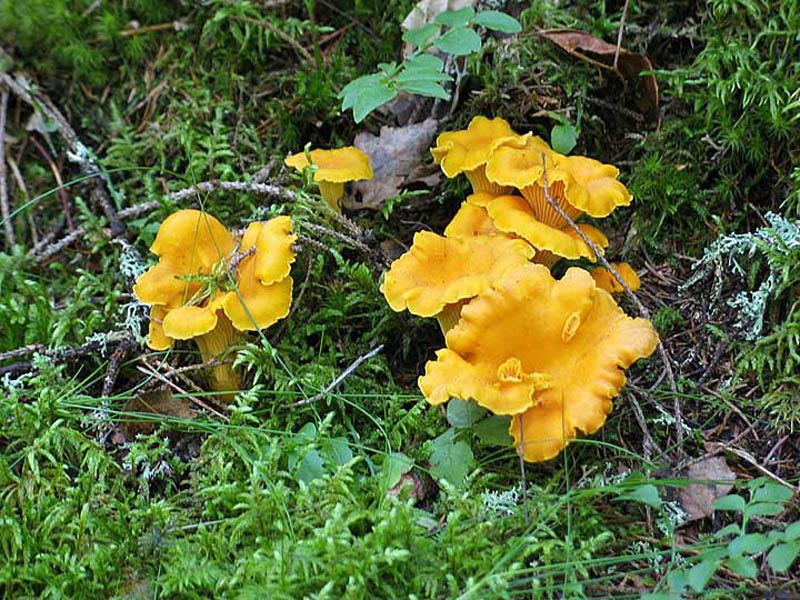
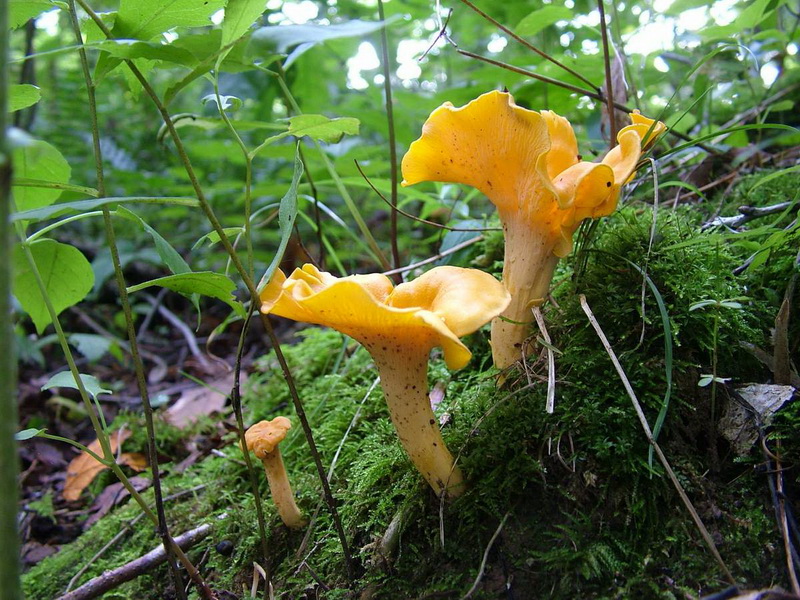
Common chanterelle (Cantharellus cibarius) is an edible mushroom. The cap is 2-12 cm in diameter, convex at first, then pressed in the center in the form of a funnel with a solid or lobed-folded edge, quite fleshy, yellow or yellowish-white. Plates in the form of forked-branched veins or folds of skin of the same color as the stalk, strongly descending along the stalk. The stem is 2-10 cm long, 0.5-2 cm wide, the same color as the cap. The pulp is dense with pleasant smell, whitish or yellowish.
It forms mycorrhiza with birch, spruce, pine and oak.
You can find it from June to November. It is especially valuable in June and July, when there are few other mushrooms.
This chanterelle mushroom looks almost the same as the inedible false chanterelle, but it is more regular in shape.
The common chanterelle is edible both young and old. Does not require boiling. Fried chanterelles are especially tasty.

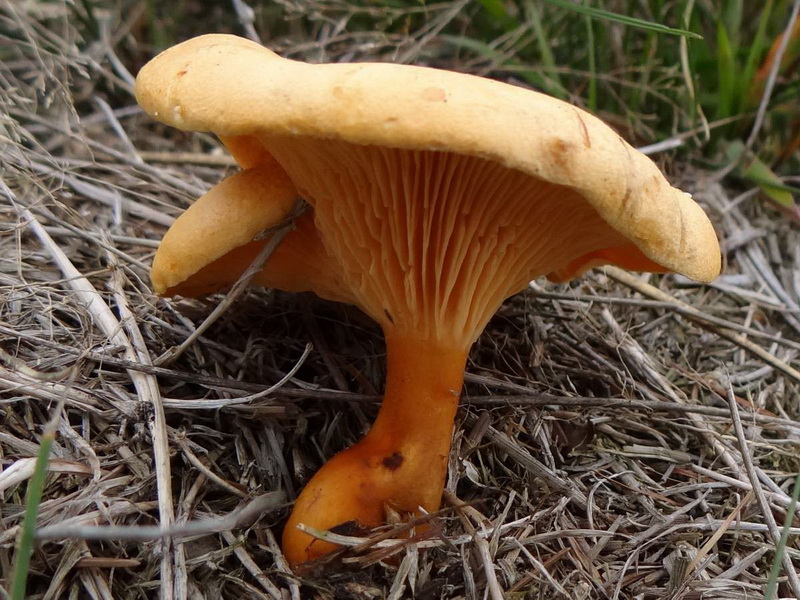
False fox (Hygrophoropsis aurantiaca) - the mushroom is inedible. The cap is 2-12 cm in diameter, convex at first, then pressed in the center in the form of a funnel with a curled edge, orange or buffy, fading to a reddish-whitish color with age. The pulp is dense yellow or orange. The plates are frequent, thick, forked-branched, the same color as the stalk, strongly descending along the stalk. The leg has a regular round cross-section, 2-5 cm in length, 0.5-1 cm in width in the lower part, where there are no plates, the same color as the cap. The spore powder is pale cream.
Grows in sparse pine and pine-birch forests, on heather heaths. Found in large quantities.
You can find it from June to November.
The false fox is similar to the real fox. The false chanterelle has real plates under its cap, while the real chanterelle has thick veins or folds instead of plates.
You can see different types of chanterelle mushrooms in this video:
Chanterelles are bright, elegant mushrooms, their yellow-red outfit glows in the darkness of the forest, attracting mushroom pickers. How beautiful these mushrooms are! They prefer to grow up in large families. If you come across one mushroom, look around to see if there are any chanterelles growing there, perhaps they are hidden in the moss or under fallen leaves.

These mushrooms, always growing en masse, appear in several waves from early summer to mid-October. The main harvest of chanterelles usually occurs throughout August and the first half of September. After a warm rain, they immediately pour out in huge piles, stripes, and circles. Chanterelles grow in mixed forests with birch, pine or spruce, and are also found in oak-pine, aspen-pine forests. They love light and therefore settle on forest clearings, along roads and clearings or in sparse forests. They prefer sandy soils, but are almost never found in limestone soils. So, for example, in the area mushroom season all the forests are simply covered with a yellow carpet of chanterelles, so on the highway they are sold for 50 rubles per bucket. And in the area of Ufa and the surrounding environs there are no chanterelles; the nearest sandy soils with pine trees, so beloved by chanterelles, are at least two hundred kilometers away, and in almost any direction. But where they are found...
In a forest clearing you can meet foxes of all ages. The young are convex, neat, even, like buttons, sewn to the ground in a row. Older ones - already with a high leg, but still even, still with a flat cap, fleshy, dense, just what a mushroom picker needs. They can be collected in any container - they do not wrinkle or crumble. By old age, the elastic body of chanterelles becomes rubbery, the cap takes the shape of a funnel with uneven, sinuous, and sometimes torn into separate blades edges.
Black chanterelle (horned funnelwort)
This mushroom is also a relative of the true chanterelle. Although appearance You can’t say that right away. The mushroom is soot-colored; there are no folds on the outside, characteristic of chanterelles. Due to the special shape and color, this mushroom has many names, for example, “black horn”, “horn of plenty”. In some places the mushroom is called the “pipe of the dead” and is associated with the intervention of evil spirits.
The taste of black chanterelle is not inferior to yellow one. Dishes made from it are more spicy and spicy. It is believed that the mushroom smells like ripe peaches. The flesh of the black chanterelle is thin, dry, and gristly.
The black fox grows in various places throughout the country in large groups, literally scattered, in colonies among the forest floor. But the dark gray color camouflages it well under the forest floor.
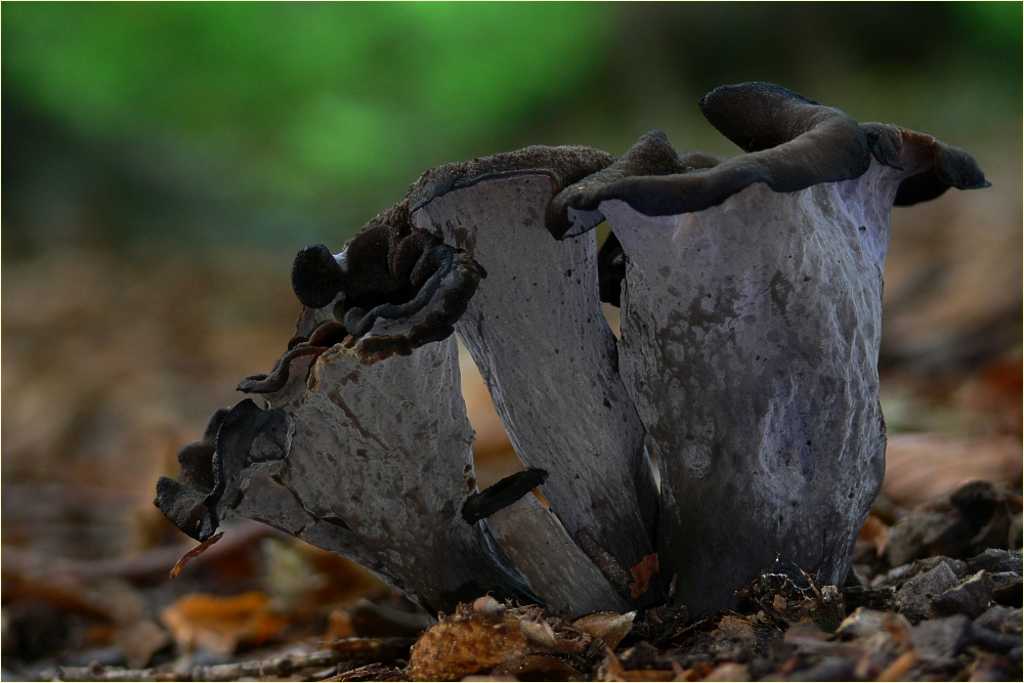
![]()
A real fox also has doubles.
Sometimes inexperienced mushroom pickers confuse chanterelle, which is inedible due to its unpleasant taste, but not poisonous. false chanterelle. It belongs to the lamellar mushrooms and grows in late summer, often in autumn, in coniferous forests. If you look closely, the false chanterelle can be easily distinguished from the real one. Firstly, the false chanterelle's cap is not yellow, but orange, quite bright. Even if it faded from old age, it still became not yellow, but reddish, with lighter edges, always smooth, not wavy, like a real fox.
Secondly, in the false chanterelle, the cap and leg do not form one whole, as in the chanterelle. The false chanterelle has obvious plates, not folds, red-orange, frequent. The leg is also bright, like the plates, thin. In general, the whole mushroom is thinner and flimsier compared to a real chanterelle. And it has an unpleasant smell. But if you accidentally got into your cart false fox, don’t be upset, the mushroom is edible, although tasteless. 
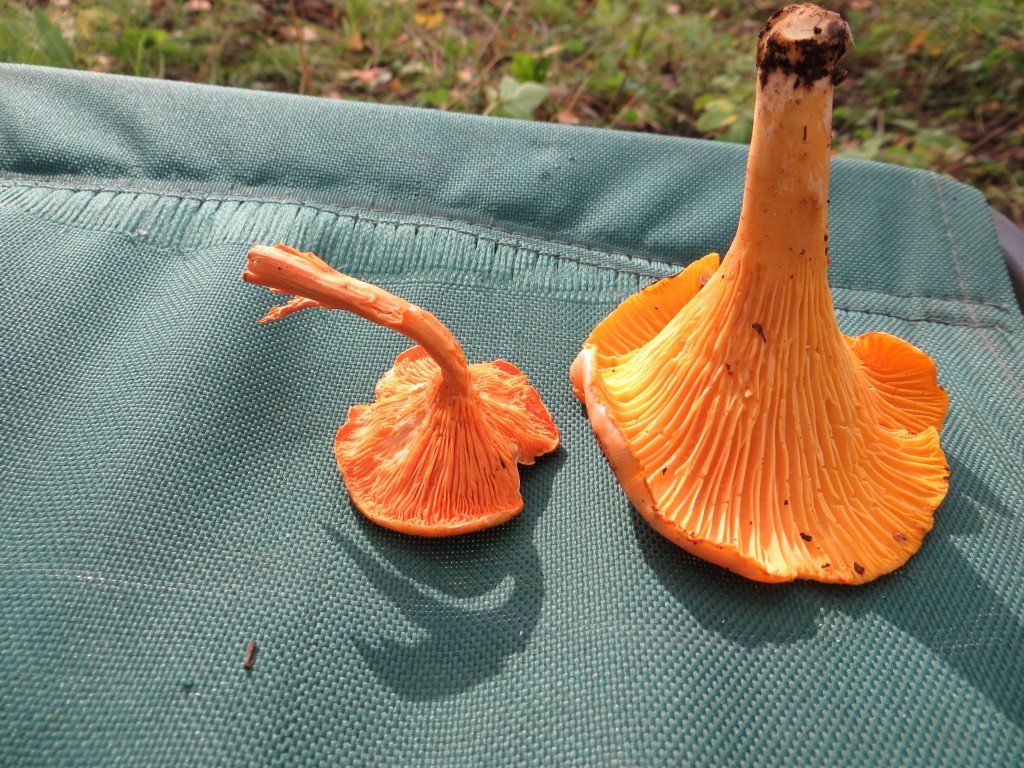
In the forests you can find mushrooms that look like young chanterelles. The same shape of hats with wavy edges. And in most cases the color is golden, like that of chanterelles, but it can also be more faded - creamy, whitish-yellow with a pink tint. But this mushroom is similar in it doesn't look good until you rip it off and look at the underside of the cap. Instead of plates, you will see spines and needles, like on the back of a hedgehog. And then everything will fall into place. In front of youdeaf fox or yellow hedgehog(literal translation from Latin hydnum emarginata). Quite an edible mushroom, but special taste does not possess. Its flesh is brittle, the spines quickly break off when touched. Yellow blackberry is better suited for general mushroom frying than as a separate dish.

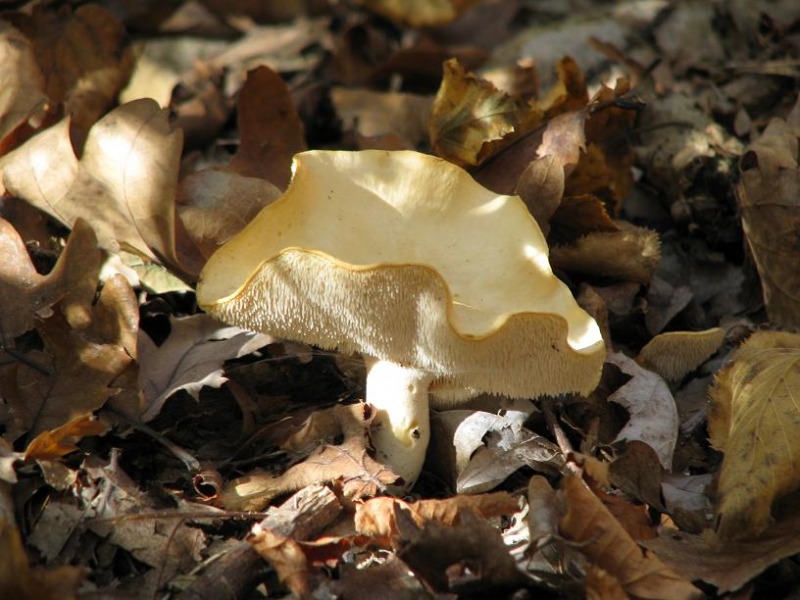
For some reason, some people consider the real chanterelle to be a tasteless mushroom - hard, rubbery, with a slight bitterness. And they collect it only for the fact that it is not wormy. Although in Europe chanterelles are valued and considered a gourmet mushroom, they are used to make various sauces, soups, and add to salads. What's the secret? The thing is that water harms chanterelles. Mushrooms absorb it like a sponge and acquire that very “rubbery” quality. After harvesting, chanterelles should be processed with a minimum amount of water, lightly rinsed under running water and wiped with a damp sponge. In this case, it will not have time to become saturated with water. And under no circumstances should chanterelles be boiled, unless you add them to soup, of course, but they are better suited for soups dried chanterelles. Chanterelles have their own unique pleasant smell and taste; they do not need any seasonings. They are good in themselves. Best dish Chanterelles make exactly zharekha - mushrooms fried on butter with the addition of grated cheese.



